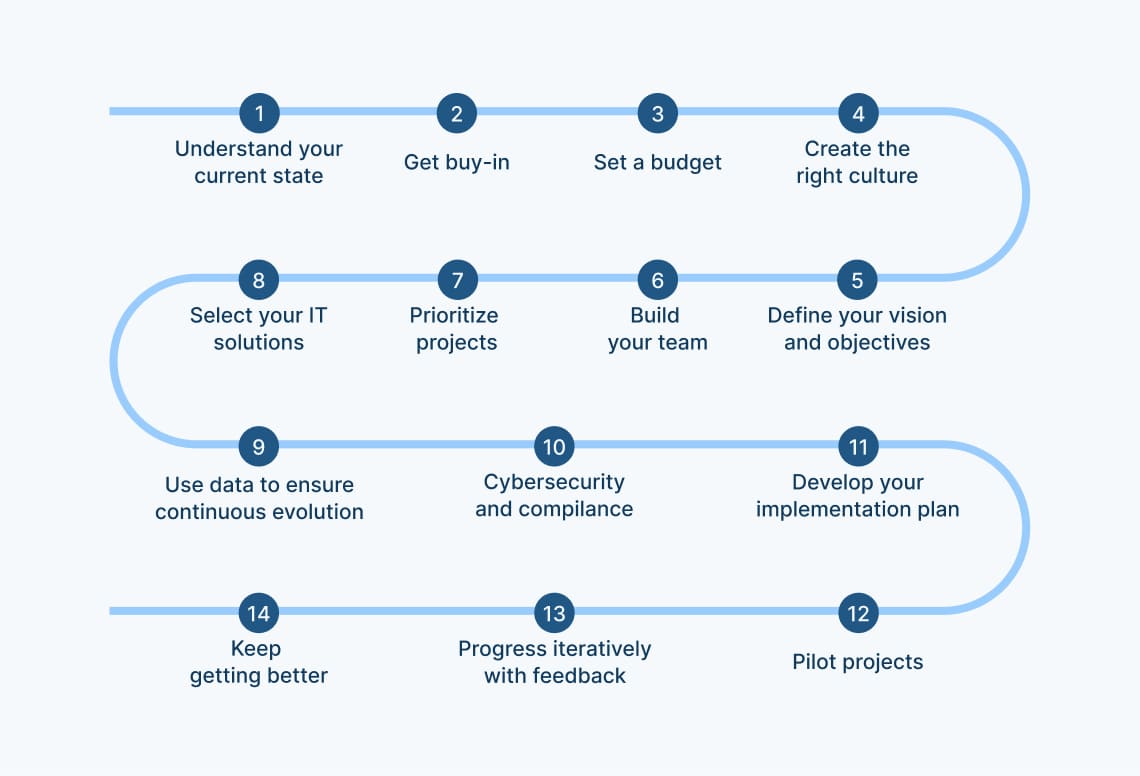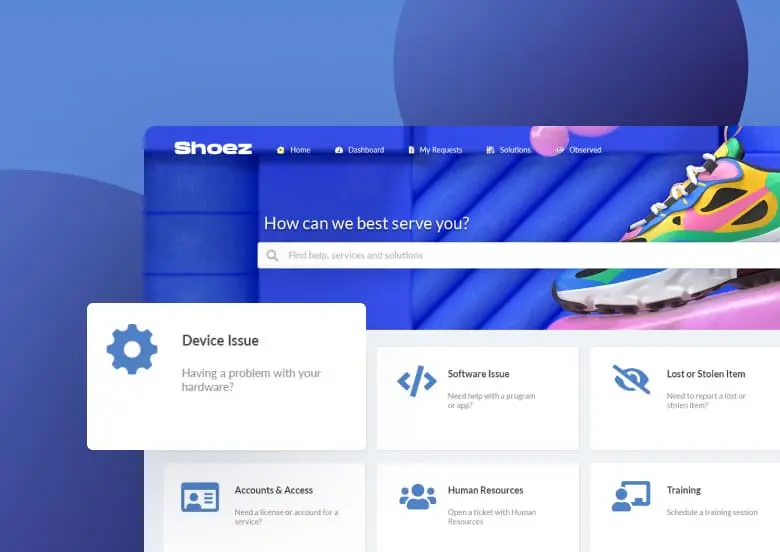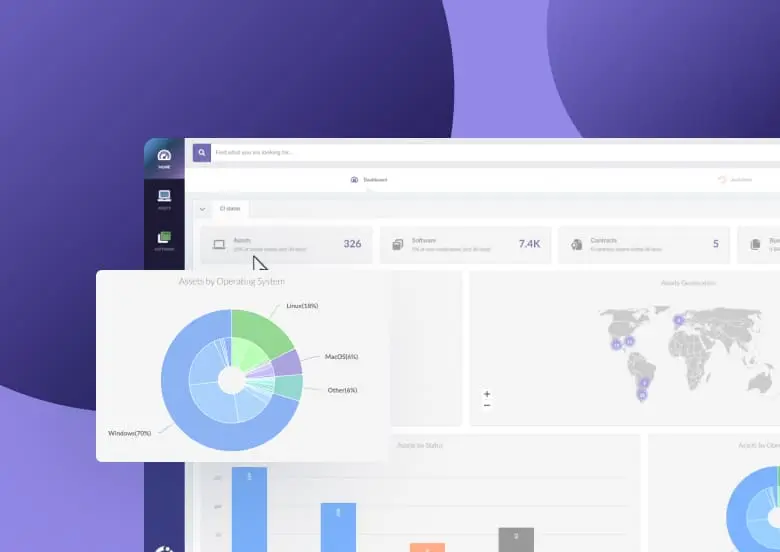Read any IT blog or article; chances are digital transformation is mentioned. But here's the thing - everyone talks about the need for it, but how do you get started? How do you make sure it actually delivers value to your business? The reality is that many projects fail due to scope creep, resistance to change, or unforeseen costs.
In short, for your initiative to be effective, first you need to understand what the process encounters. And then you must have a solid plan to follow. In this article, we will break down the steps to create a solid digital transformation strategy for 2025, including practical examples and tools.
Are you ready to learn more? Let's start.
Table of contents
- What is a digital transformation?
- Benefits of the digital transformation framework
- Digital transformation challenges
- 14 steps to outline a digital transformation strategy
- Using InvGate Service Management as your digital transformation software
- Digital transformation best practices
What is a digital transformation?
So many people use it as a buzzword, so let's get it right the first time by checking in with the experts. Gartner defines digital transformation as follows: "Digital transformation can refer to anything from IT modernization (for example, cloud computing), to digital optimization, to the invention of new digital business models.
The term is widely used in public-sector organizations to refer to modest initiatives such as putting services online or legacy modernization. Thus, the term is more like "digitization" than "digital business transformation."
Put simply, it is the process by which companies embed technologies across their businesses to create value and drive fundamental change.
Think of it like this: first, we had handwritten notes, then we had typewriters, then we had Microsoft Word or Google Docs, then smartphones and applications. Now, we're using virtual assistants and artificial intelligence (AI) to manage our day-to-day activities.
Key benefits of digital transformation include greater business agility, increased efficiency, and better outcomes for organizations and stakeholders.
Digital transformation examples
This process is being implemented across many - if not to say more or less in all - industries and sectors.
A widespread example of this is the expansion of Service Management. As organizations embrace digital transformation, a service desk solution becomes a key player acting as the central hub for managing and resolving IT-related issues, standardizing and automating routine tasks, and optimizing IT services.
And taking this a step further to leverage the benefits across the whole organization, Enterprise Service Management (ESM) software offers another sample of how embracing technology can help drive operational efficiency and business success.

Is Service Management Relevant for Digital Transformation?
Some other examples of digital transformation implemented in different industries include:
- Finance sector - Internet banking and apps enable customers to manage their accounts, transfer money, and make mobile payments.
- Healthcare sector - Electronic notes and scheduling services instead of medical staff and patients relying on paper-based notes and scheduling services.
- Education sector - The use of online platforms to support remote learning.
- Retail sector - Online shopping web services and apps to enable prospective customers to browse and then purchase products. This has matured into using data mining and algorithms to provide personalized product recommendations.
- Social housing sector - Using automation so customers can access their housing details online, pay rent, and report faults.
- Data analytics - Using data analytics to understand viewer preferences and tailor content recommendations.
- Smart meters - For home energy usage to help customers manage and track their energy use and spending.
Benefits of the digital transformation framework
Digital transformation frameworks provide a structured approach to support organizations through the process of adopting and leveraging digital technologies to achieve their strategic goals. Using a framework makes your approach more structured and easier to follow and offers a number of benefits, including:
- Better alignment with business objectives: They ensure that digital initiatives align with the organization's overall strategy and goals, ensuring that digital transformation adds value and the proper outcomes.
- Stronger focus: Digital transformation frameworks help organizations define their goals, strategies, and desired outcomes, providing a clear roadmap for the transformation journey.
- Higher commitment to quality: By leaning into digital transformation, you're making a statement to your business, its stakeholders, and its customers. Digitizing processes and services helps to improve their quality, reducing the potential for backlogs and human effort, and delivering the best possible outcomes for your people.
- Improved Customer Experience (CX): Digital transformation frameworks focus on customer centricity. By putting the customer at the center of everything you do, you will build products and services that will enhance the experience, leading to better outcomes for both your organization and its customers.
- More efficient working practices: Frameworks promote the efficient use of resources and technology, optimizing processes to improve productivity and reduce costs.
- Stronger competitive value: By encouraging innovation and higher quality work processes, they help organizations stay competitive in the evolving digital landscape.
- Data-driven decision-making: Frameworks add structure and promote the use of data analytics and insights to make informed decisions, leading to better outcomes and a competitive edge.
- Increased agility capabilities: Frameworks include strategies for agility, allowing organizations to adapt quickly to changes in the market or technology landscape.
- A more collaborative working environment: Frameworks encourage collaboration across different departments and functions within an organization, breaking down siloed ways of working, improving communication, and promoting a culture of collaboration.
- Better support for Governance, Risk, and Compliance (GRC): A structured framework can help identify and mitigate potential risks associated with digital initiatives and ensure that the appropriate controls are in place so the organization can comply with any legal and regulatory requirements.
- Streamlined scalability: Digital transformation frameworks enable organizations to scale their initiatives over time, ensuring that IT service delivery can support increasing demands and business needs.
- Enhanced competitive advantage: Digital transformation increases the focus on new technology and ways of working, enabling organizations to develop an edge over the competition.
- Higher cost savings: Streamlining processes and reducing paper-based, manual tasks through automation can lead to cost savings over time as there will be less effort involved and less potential for error.
- Support for sustainability: Many digital transformation frameworks promote sustainability best practices. This way, organizations can implement these practices and technologies that reduce their environmental impact.
- Improved Employee Experience (EX): A well-executed digital transformation initiative can lead to better job satisfaction for employees as they work with more efficient, user-friendly tools.
- More measurable results: Digital transformation frameworks incorporate Critical Success Factors (CSFs). Key Performance Indicators (KPIs) and metrics to measure performance allow for greater accountability, transparency, and support for continual improvement.
Four digital transformation challenges
However, implementing a digital transformation is a large project that involves working with many variables. Some of the most common challenges associated with this process include:
- Resistance to change: One of the biggest challenges of digital transformation is related to people. Think about it. We get comfortable working in specific ways, and change can be challenging. Sometimes, colleagues will resist changes to established processes, systems, and working practices, making it more difficult to implement new services and ways of working.
- Lack of digital skills: Many organizations face a skills gap, with employees lacking the necessary digital skills to use new applications, services, and devices effectively. When building a digital transformation strategy, it is essential to factor time and resources into training all colleagues so they are comfortable using new technology. Training and upskilling are imperative but time-consuming.
- Legacy systems: Chances are there will be older legacy systems in your organization that the business will be unwilling to replace. Integrating new digital technologies with existing legacy systems can be complex and expensive.
- Data Management: Handling and analyzing the data and information generated by digital transformation initiatives can be a big task. It's also important to have a plan for managing any data privacy and security requirements. Another Data Management challenge is fragmentation. The adoption of multiple tools and services can lead to fragmentation, making it more challenging to manage and coordinate across different systems.
Paul Wilkinson came onto out IT podcast, Ticket Volume, to speak about the main reasons he sees that make digital transformations fail, highlighting a lack of alignment between technology and business goals and too little emphasis on developing real skills and changing the business culture.
14 steps to outline a digital transformation strategy

A digital business transformation strategy is a detailed plan that outlines how your business will use technology to establish or enhance processes and outcomes for your customers and stakeholders.
Your digital transformation strategy should include the following steps:
1. Understand your current state
Conduct a thorough assessment of the technology, processes, and systems you already have in place. Identify where digital transformation can make the most significant impact and areas that may need the most attention.
2. Get buy-in
Gain support from senior leadership to ensure that the digital transformation strategy is endorsed and adequately resourced. Digital transformation is something that needs the support of your Senior Management team, so really think about their current needs and challenges. Things to consider could include:
- The number of hours lost due to manual or outdated processes.
- Rework or duplication due to human error.
- Delays and silos.
- Heavy reliance on legacy systems or equipment.
3. Set a budget
Determine the budget required for your digital transformation initiatives, considering costs for technology, training, people costs, and ongoing maintenance and support.

The Beginners Guide to IT Budgeting
4. Create the right culture
Don't forget about people. So many people hear the word digital transformation and immediately think that it's all too much to deal with, but the fact of the matter is that it's much simpler than that.
By creating the right culture, you're making a way of working that empowers your people to work together as one team rather than having lots of individual bubbles or silos. This will result in more effective and efficient working practices, shared ideas, and improved customer and colleague outcomes.
5. Define your vision and objectives
Identify your organization's goals for digital transformation by actively engaging with the rest of the business. Understand and confirm the specific outcomes and improvements that are needed, for example, enhanced customer experience, increased process efficiency, or new revenue streams.
Try to talk to representatives from every service tower and use practices like active listening to ensure outcomes are clearly understood. If multiple colleagues are asking for feedback, consider using forms and templates for the data capture stage so that your business requirements are captured accurately and consistently.
Once captured, build these objectives into your strategy so that your digital transformation agenda aligns with the wants and needs of the business.
6. Build your team
Assemble a team with the right skills and experience. This will include IT colleagues, project managers, Change Enablement practitioners, and key stakeholders from each department in the business. Make sure you've clearly set out the roles and responsibilities for team members and preferably documented them in a RACI chart.
7. Prioritize projects
Based on your data capture phase, identify specific projects, improvement initiatives, and pain points that align with the strategy and prioritize them based on their potential impact and speed of implementation.
8. Select your IT solutions
Select the IT services and platforms that best fit your organization's needs. Ensure that they are scalable and can integrate with existing and legacy systems and ensure that support for integration and APIs are codified at a contractual level.
For this stage, designing a Request For Proposal (RFP) is a valuable tool to ensure you can compare the different options fairly and guarantee your chosen vendor meets your needs. When engaging new IT solutions, questions to ask include:
- Will this technology deliver the outcomes we need? Are there any case studies or reference sites we can reference?
- Does the vendor share a similar vision for digital transformation? Are we aligned on common goals?
- Will the supplier be able to support you in your long-term business strategy?
- Will the technology and supplier support scaling? Is the license model flexible?
- How does this integrate with your existing technology? Are there any legacy systems that need to be looked at in terms of integrations and APIs?
- How will the relationship be managed to ensure that the technology continues to add value and both sides continue to be aligned?
In the following section, we will explore how to leverage InvGate Service Management to implement a digital transformation strategy across your organization through a comprehensive Service Management tool.

9 Service Desk Features That Will Boost Your ESM Strategy
9. Use data to ensure continuous evolution
The use of data is a key driver in successful digital transformation projects, and for good reason - knowledge is power. Develop a strategy for data collection, storage, and analysis to support data-driven decision-making and personalization. Data personalization can be a game changer; businesses can use the insights gleaned from data insights to identify and implement service improvement activities.
Examples of improvements could be process refinements or improving the commercial website to improve customer experience. By leveraging data, businesses will be able to make better decisions. Rather than trying to guess what is important to your customers and stakeholders, you will have the data to confirm what is needed so you can act accordingly.
10. Cybersecurity and compliance
Prioritize IT security and support for your organizational GRC obligations by implementing solid cybersecurity and data protection measures and adhering to the appropriate compliance, legal, and regulatory standards.
11. Develop your implementation plan
Work with your Project Management team(s) to create a plan for each project, including timelines, milestones, and KPIs, so you can measure how well your project is performing. Make sure that your project plan includes provision for early life support to ensure that any transition issues are captured and dealt with quickly and effectively.
12. Pilot projects
Launch pilot projects to test new technologies and processes on a smaller scale before a full-scale, big-bang implementation. Communication is vital at this stage, so gather feedback from all stakeholders so that you can tweak your approach and course correctly based on the results of your pilot approach.
13. Progress iteratively with feedback
As pilot projects progress and are successful, scale them up and gradually implement additional initiatives. Continuously monitor and measure the progress and impact of your digital transformation efforts. Actively encourage feedback from colleagues, customers, and Senior Management and use this input to refine your approach and make ongoing improvements.
14. Keep getting better
Keep the momentum going by being proactive about innovation, market conditions, and technology advancements. Continue to ask for and act on feedback so that your digital transformation efforts continue to grow and support the business.
Using InvGate Service Management as your digital transformation software

As we mentioned earlier, ITSM is a key driver of digital transformation. Centralizing service delivery and leveraging a service desk solution helps teams manage their workload more efficiently and at the same time improves the employee experience across the whole enterprise when requesting support.
For this, InvGate Service Management is a comprehensive ITSM tool that incorporates a robust ticketing system to manage, track, and solve incoming requests swiftly. Along with its automation feature, reporting capabilities, and integration offerings with a wide range of applications, the solution ensures that technology is working towards organizational success.
Also, its user-friendly interface helps guarantee user adoption (even for those who are less tech savvy), avoiding the return of informal communication channels and guaranteeing everybody is on board with the digital transformation process.
If you want to see everything the tool can do for your digital transformation strategy, don’t miss the chance to book a quick call with our experts where you can clear all your doubts!
Four digital transformation best practices
Implementing a digital transformation strategy can be complex, but adhering to best practices can significantly enhance the chances of success.
Here are four digital transformation best practices to assist you during the process:
- Look for improvement opportunities - Look for specific improvement opportunities is key to not get overwhelmed; if you have departments that are reliant on paper-based processes, engage them in your transformation efforts. Spend time shadowing them and identifying their challenges. Some examples may include:
- Requests are getting lost in paperwork.
- Duplication
- Team members working in their silos are missing opportunities for improvement.
- Inconsistent ways of working lead to mistakes and rework
- A push-based system causes bottlenecks and delays.
Work with each team to understand their processes and then prioritize each improvement opportunity, adding them to your overall work plan.
- Start organizational transformation - Digital transformation starts within and requires the cooperation of an entire organization in order to be effective. As well as getting buy-in from Senior Management, you need to ensure that teams across the organization have all the training, tools, and resources in place to successfully embrace new services, outcomes, and ways of working. This will lead to more engaged colleagues, more flexible and supportive work practices, and a more cohesive business ecosystem.
- Focus on people - Down a similar line, when building your digital transformation strategy, put your people - your colleagues, your stakeholders, and your customers at the heart of everything you do. By focusing on people and outcomes, you use technology in a way that supports them rather than risk automation for the sake of it, and you can focus your efforts where they are needed the most.
- Lean into agile ways of working - The digital landscape is constantly evolving, so a successful digital transformation strategy must be willing to engage with new technologies and become more adaptable and flexible in its approach. Organizational ways of working must foster a culture that embraces both change and continual improvement.

10 Tips for Getting Started with Digital Transformation
Key takeaways
Implementing a successful digital transformation strategy will mean you are using technology to create or improve processes, working practices, and services, in order to meet changing business requirements and get better outcomes for colleagues and customers.
A solid plan is essential because it guarantees alignment with business goals, keeps everyone on message, and prevents soap creep. And, along this, you need the right tool to ensure a smooth adoption process and that the technology is working towards your needs.
To check out how InvGate Service Management can support your digital transformation strategy, book a free 30 day trial and navigate the solution in your own time!
Frequently Asked Questions
What are the four main areas of digital transformation?
There are four pillars of digital transformation to keep in mind—organization transformation, moving from waterfall to agile, creating a customer-centered approach, and adopting and integrating emergent technologies.
What is the difference between digital transformation and digital strategy?
Put simply, your digital transformation strategy means having a plan in place, ensuring everyone is aligned, and the key deliverables are documented. Digital transformation is doing the work, putting that plan into action.
What is a digital transformation strategy?
A structured plan for carrying out the transformation activity.
How do you develop a digital transformation strategy?
You create a plan - look at what you have in place so far, identify pain points, agree on objectives, and build a roadmap. Communication is vital; you will be regularly checking in on stakeholders to ensure your plan is on track and the proper outcomes are being achieved.
How do we measure digital transformation progress?
Use KPIs and metrics so you can measure improvements and how far you've come.
Why is digital transformation essential for business growth?
To keep up with current demand and to ensure that the technology that underpins business services continues to evolve and adapt to the needs of the business.
Is AI part of digital transformation?
AI is absolutely part of digital transformation. The use of automation and AI can make processes and working practices leaner, more efficient, and easier to engage with.

















